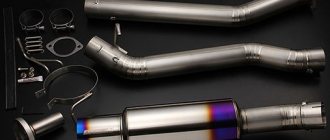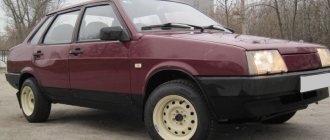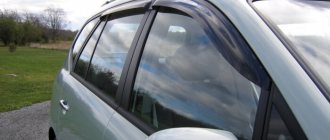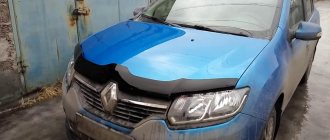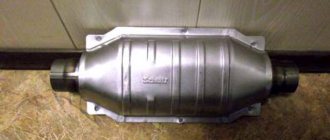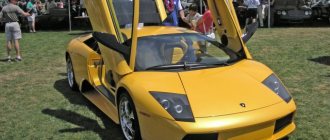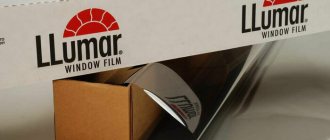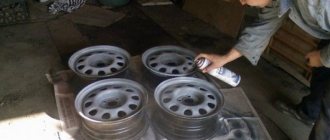- home
- Tires and wheels
- …
We seem to have become accustomed to extremely lowered cars But it’s not like that, now another dangerous fashion has started, now instead of normal disks, they are starting to install so-called “unwelding”. Or they combine everything together (lowered suspension + unwelding). But what is all this for? Where is the semantic load? What are the pros and cons of such an installation? Today in detail...
First, a little definition.
“Unwelding” (or cut and then welded car rims) is a youth tuning trend, namely changing the width to allow the installation of very wide tires. In simple words, they make one from two disks, but with a larger width. Of course, there are other methods that use a steel strip in the middle, but more on that below.
I WOULD LIKE TO EMPHASIZE no speed characteristics that improve the driving properties of the car are observed, I would even say on the contrary - the speed characteristics deteriorate and fuel consumption increases.
This is purely “PULL-UP” – NOTHING ELSE, ACTIVELY THE SAME AS LOWERING THE SUSPENSION.
What kind of discs are they made from?
As a rule, ordinary stamped discs . After all, they are easiest to cut and then cook as needed. Casting and forging are thus virtually impossible to cut and then join. THIS IS SIMPLY NOT POSSIBLE.
To be fair, it is worth noting that wide cast or forged options do exist, but they are really rare! They are made almost to order in small batches, so they will be very expensive. Although you can select a bolt match, that is, adjust the approximate characteristics.
Methods for tuning wheels
There are many ways to diversify the appearance of your wheels. All of them, to one degree or another, require DIY skills, and some require special equipment.
The easiest way to change something in the wheels is to install new plugs. They will create some zest in appearance, while simultaneously covering up unattractive parts of the structure.
Putting new plugs on the wheels is the easiest way to tune wheels
Painting wheels is very popular. You can choose any color you like. Sports car owners often choose bright neon shades of yellow, red, orange, purple and green.
Sports car owners love painting rims in bright colors.
Others paint the car completely black, not forgetting about the wheels. Such vehicles look incredibly stylish and mysterious. However, most motorists opt for classic chrome plating, which creates a metallic, almost mirror-like coating.
Chrome plating gives the wheels the appearance of a glass surface
In large cities you can find cars whose rims seem to be strewn with precious stones. In fact, everything is practically like this: this is an inlay technique that uses Swarovski crystals
Such wheels will certainly attract the attention of everyone around. Of course, it is almost impossible to perform this type of tuning in a garage.
Even if you try, the appearance will not be identical to what the professionals can achieve. In addition, the raw materials used will cost you a very large amount.
If you want to inlay discs with stones, then contact a special workshop
Many motorists resort to a tuning method such as welding. It increases the width of the parts, making them more similar to the elements of large jeeps.
Wider wheels give the car a more powerful look
Another popular method is installing backlighting. Such cars look very impressive in the dark. And the variety of color combinations allows your imagination to run wild.
Illuminated rims are a fun way to highlight your car.
Of course, not all of the listed tuning methods can be done with your own hands. Therefore, we will focus on the most popular types, and also tell you how to cope without the help of auto repair shops.
About the width of the disk
Usually a standard disk, now we are talking about stamping, has a wheel size of 6.5J. If translated into Russian, then this width is 6.5 inches, that is, from the front to the back wall. But the letter “J” denotes the profile of the side flange of the rim; at the moment it is the most common. For example, there could be JJ, JK, K or just L.
It is 6.5 J that is now the default size, which is why the letter J is often simply omitted, because all disks are the same, why indicate that!
Accordingly, you can only install standard-width tires, but what to do - when you want it to extend beyond the arches and body of the car, for example, you want to install J tires ? Still, the difference is 3.5 inches, which is 2.5 X 3.5 = 8.75 cm!
Ask: “What is the limitation on the welding width?” YES guys, you can make a rim of almost any width you need, so there are often options with sizes larger than 10J, the size is not limited by anything - only by your monetary policy, because such tires will not be cheap.
To be honest, it is difficult to get such tires; they are usually ordered from abroad in the USA, European countries, etc. After such a disk is made and tires are purchased, you can assemble the structure, which is also not so easy.
The first method for making boiled discs
Boiling means that two identical “stampings” are connected to each other. First you need to prepare your tools.
- Drill with several drills. It is best to choose drills for 10.4.
- Seam sealant
- Welding machine and preferably the welder himself
- Grinder, which comes with several replaceable attachments (discs)
First, we need to prepare the metal “stamping” disks themselves. It’s good if they are new or have a smooth surface. But usually it is for unwelding that they take used disks.
It is necessary to evaluate the “stampings” and their condition. You need to look through and check their surface to understand how smooth it is and suitable for welding. There are some tips for those who have dealt with this problem. We clamp the car hub in a vice, on which we will subsequently install the welded “stampings”. The disc rotates after being installed on this hub. This allows you to record a certain beat. You can also put a “stamping” on the drive axle of the car if you cannot find a separate hub.
There are only two ways to evaluate runout. If you simply press on the gas, then the very fact of the presence of a beat is assessed. A ruler is also used for this. It must be applied both in the vertical and horizontal planes to obtain the required value. Disc runout is considered normal if it is within 1-2 millimeters. If in any of the planes the indicator is more than 2 millimeters, the “stamping” must be corrected using special equipment for repairing disks.
If there is a more even “stamping”, then it plays the role of a basis for welding. To avoid confusion later, it is better to note it right away. Then the second “stamping” will become the rim for us.
Then you can move on to the second stage of work. From the second “stamping” the outer rim is cut off, this is done using a grinder and cutting wheels. As for the main disk, we need to cut it in the area of the outer rim until we find the inner part. It's better to stop as close to the middle as possible. The rim can then be easily removed and thrown away. We definitely won't need this part anymore. Only the inner rim remains from the second “stamping”; on the base it will become the outer one.
Apply joint sealant to the center of the boiled disc. This is done before the paint needs to be applied to the surface. After the composition has dried, use sandpaper to remove excess materials. An ordinary chisel is also suitable for this. Only at the last stage do we carry out painting.
How to do it yourself?
At this time, there are only three main types of manufacturing such disks:
- Connecting two disks. They are cut in a certain way so that the middle part of one is wider and then connected by welding. Thus, out of two, only one disk is obtained.
- Insert into the middle of a metal strip. The disk is cut, then a sheet (strip) of metal (usually steel) is installed in the middle, similar in characteristics to the base material. Then the whole thing is welded.
- Combined method. It should be noted that it is practically not used, because it is the most complex and very easy to make a mistake. The inner and outer parts of the disk are separated, a strip is welded in, and the hub part is transferred, sometimes the inner and outer parts are changed.
I will say this, the first two points are the most popular now; it is with the help of them that most of the “unwelding” for cars is now done. The method of inserting a strip into a welding disk is especially popular. Now a short video.
I would like to note that it is very difficult to do it yourself, practically impossible, you need to maintain proportions, you need to maintain the size of the welded strip, weld the disc correctly, process and paint it. If something is violated, then all the work can go down the drain.
When did such tuning appear?
In cities such as Moscow, St. Petersburg, Minsk or Kyiv, you can find a fairly large number of car owners whose cars have welded rims installed.
Although many consider this the prerogative of purely sports cars, welding is installed on Gazelle and UAZ cars without any problems. Even for Oka, such tuning is not prohibited.
see also
Manual impact wrench: “meat grinder” for a passenger car, review and reviews
If you look into the history of auto tuning in Russia, then the first examples of cars with welded rims appeared around the mid-70s of the last 20th century. These wheels were used by cars that took part in all kinds of competitions and competitions. In fact, installing a dewelder gave them a certain advantage when driving, since the car could accommodate wider tires.
Most often, welding is done by fans of this type of car competition such as drifting or drifting.
This is due to the fact that the modified wheels provided better maneuverability and reliability when keeping the car on the track.
The popularization of tuning was growing at a rapid pace. Similar solutions can be found on many cars.
Popular cars on which you can find boiled rims include:
- Nissan 350Z;
- Nissan 370Z;
- Toyota Mark 2;
- Toyota Chaser;
- Nissan Skyline;
- Mitsubishi Lancer;
- Honda S2000;
- Honda Civic;
- Ford Mustang;
- Dodge Charger, etc.
But the list is not limited to these cars.
The most important thing is to understand what it is, why welding is needed and whether it is even worth using it on your own vehicle.
Pros and cons of unwelding
What can I say, there are positive and negative aspects, but there are very few positive ones.
pros:
- The original appearance of cast or forged designer wheels now in bulk won’t surprise anyone, but I’m more than sure that there are VERY FEW welds.
- Cheap and original tuning . Indeed, this is a fairly cheap tuning, boiling and welding the disc does not cost exorbitantly, if you have found used tires, then such a transformation will generally be affordable.
- Larger contact patch . It can help off-road; the wider the wheel, the better the cross-country ability.
Actually that's all! Now let's talk about the many more disadvantages.
Minuses:
- I'll start, perhaps, with tires . After all, it is practically impossible to find wheels R13 or R14 - “WIDE”, there are no such sizes as 175/50 R13, 195/45 R13, 185/45 R. You have to look at used ones from other countries.
- Strength and sealing of the seam . Guys, even a well-welded seam may not be airtight. And it can easily break, which is dangerous at speed on the road.
- Tire fitting problem . After all, installing this rubber is not so easy; it often has to be installed “by explosion.”
- Loss in dynamics . Wheels and rims are heavier, and significantly so, acceleration and dynamics are much more difficult than with standard sizes.
- Fuel consumption . Approximately 15 - 20% is added to the consumption.
- Wheel bearings . Their service life is reduced due to the heavy load on the axles.
- Track . The car really slides along the ruts, especially noticeably in winter! If the disk is still 7.5J, then this is not so noticeable, but if 9.5 - 10J, then this is very noticeable at speed. If you hesitate a little, you can fly into oncoming traffic, which actually has lethal consequences.
As you can see, there are many more disadvantages, in fact, which was what needed to be proven. In fact, plus one is the appearance, THAT'S ALL! Weigh the pros and cons before installing welding joints; you may no longer need it.
This is where I end, sincerely yours, AUTOBLOGGER.
Similar news
- Winter tire tread
- How to choose summer tires? For an ordinary car, useful...
- Retreaded tires (welded)
Add a comment Cancel reply
Workshop – Making unweldings. Part 2 “RESET”
Since the first post about unwelding was made, a lot of water has passed under the bridge. Then it was a test of this topic, and what’s nice is that this topic aroused great interest from the public. When that post was written, I knew that it would not be the only one on the topic of welding. The method described there is good in certain conditions, but has a big drawback - you need two sets of disks to make one from them. It’s kind of expensive, isn’t it?.. Another method seemed much more interesting and correct to me. You only need one set of disks, any width is available, the shelf is more beautiful.
We didn’t write about the second method of making weldings for a long time because we wanted to try everything ourselves and describe our own experience. Everything is for you!
Without unnecessary lyricism - straight to the point. We took a set of disks. Better in good condition. In our case, it was a used kit. The general idea is described by the following illustration.
We cut the outer rim of the disk approximately in the middle, perpendicular to the axis of rotation, but a little closer to the outside relative to the welding points of the outer rim and the hub part of the disk. (This is the most difficult sentence in the article.) You must be careful and not cut the hub part, at least not all the way through . A small cut is not scary - later there will be welding in this place. Carefully separate the two parts of the disk from each other. Some people manage to saw off with a hacksaw, but it is much better to do it on a lathe - it turns out much smoother and more accurately.
Exactly cut off a strip of metal of the required width and bend it. The thickness of the metal, as far as I remember, is 3mm. You can bend it any way you like, but it’s better to use special rollers. Next, we take part of the disk with the hub and attach the strip to it. The hub part holds the strip well and sets it in the right direction. (I stole the next three photos with a black disk from our colleagues from the comments in the first article)
Next, we attach the strip to the second part of the disk. And we weld all the seams, trying to make sure that the disc does not move. It’s good if it is possible to automatically weld a rotating part - everything is much stronger and more predictable.
We clean the seams and check that everything is holding together. It’s good if you have a lathe to clean the seam on the disk shelf in the place where it will later please the eye. This will also help correct the geometry of the disk if it is slightly disturbed (and this is very likely). Even if everything is done carefully, it is advisable to roll the resulting discs before painting to be sure of their geometry. Our weldings pleased us with the quality and, despite the seemingly not very smooth rim (the rims were used), they showed minimal runout.
Next we send the wheels for painting. Ours were sandblasted and powder coated. On the side of the disk that is usually hidden from view by the tire, it was decided to leave reinforcement of the weld seam (i.e. the seam itself). On the front side the seam was ground off. The discs were assembled without tubes and they hold pressure perfectly. Thanks to factory manufacturing conditions and automatic welding.
See how our welding joints were installed on the car in the section about the Low Aster and specifically in this post.
To be fair, I note that this method is universal in every sense. I assumed here from the very beginning that most often everyone needs to boil the disk outward to get a shelf and a specific look. But needs and ideas are different. You can boil the disk in the other direction.
This is what happened with the test welding. We weren’t very happy about this at that moment, but now we can show these photos here. The seams are not additionally processed and are clearly visible.
If you use a little imagination, it’s not at all difficult to guess that you can boil the disk in both directions at once.
I will answer any questions you may have in advance. We made weldings from 16-inch wheels. The test disk was cooked to two inches. But when trying it on, the rear arch of the Astra sat on the rubber. As a result, we made the kit with a 40mm extension. There was a grandiose idea to make a video of the manufacturing process, but not all plans are destined to come true.
And here's another
One of the main questions is why and why all this? Unwelding is perhaps the cheapest way to make disks of large width and, no less important, the desired width. The appearance leaves a hint of stock - it’s a matter of style and perception
Unwelding from a legal point of view
From the point of view of law enforcement agencies, a boiled rim on a car is a change in its design. Such changes, regardless of whether it is a Niva with welding joints or a foreign car, require technical expertise. During the latter, experts check how safe the changes made are. The likelihood that widened wheels, not supported by modified suspension and appropriate tires, will be considered safe tends to zero.
Having installed welding joints on a VAZ-2107 or any other domestic car, you should be prepared for the fact that traffic police officers will issue a fine of five hundred rubles every day or ban the operation of the problematic car.
In addition, it will be impossible to re-register or deregister your vehicle. Such changes can be hidden only if the owner changes the wheels to standard ones before visiting the traffic police department.
Many car owners try to give their car some individuality in order to make it stand out from the crowd. At the same time, they go to all kinds of tricks, starting from banal stickers on the windows and body, and ending with quite serious modifications of the body and external elements.
Positive qualities of welding
Installing wheels on a car that are made according to personal calculations can have a positive impact on ride quality. At the same time, the visual appearance of the vehicle takes on the features of an active sports car.
Cooking steel discs yourself has several advantages:
- The appearance of the car improves.
- The driving parameters of the car become more secure in high-speed driving mode.
- The vehicle's grip on the road surface increases during maneuvers and cornering.
- The cost of self-welding is not high.
- The ability to create welding yourself, without the use of expensive and rarely found equipment.
VAZ 2105 on welding joints - features of welding joints on Lada cars
Surely there are car owners who hear the word “unwelding” for the first time and have no idea what they are. However, this term is well known to car tuning enthusiasts who are passionate about improving cars. So, welding is called stamped disks that have an increased width. Expanded steel wheels can change the look of any car.
Widened steel wheels can change the look of any car.
Unwelding got its name due to the peculiarities of the manufacturing technology. It’s easy to make welding joints for the VAZ 2107 and other models yourself from old wheels. This type of tuning is popular among VAZ owners; for example, a Lada with unwelding immediately attracts attention. Making welding joints yourself is an inexpensive alternative to purchased discs of increased width.
Let us consider in more detail the features of welding. VAZ cars have a minimum standard wheel width of 5J, and the maximum size, depending on the make of the car, can be 6.5J. Using regular 13-inch wheels, you can increase the width to 7J using welding joints. The fourteen-inch wheels can be upgraded to size 8J. If desired, the width of 15-inch wheels can be 10J.
Skeptics of such tuning may argue that the wheel arches will not allow the installation of such wheels with wide tires. However, for car enthusiasts, changing the wheel arch size is not a problem. After all, you can roll out the wing or trim it.
If you want to tune your car, do not forget that welding joints can only be made from stamped wheels. Steel discs can be cut and then welded. At the same time, they do not lose their presentation and strength as a result of thermal load. Cast discs cannot be welded as they are difficult to cut.
Unwelding with spacer
The second method does not require so many disks, one set is enough. But in terms of execution it is more difficult.
Let's consider it using the example of the VAZ-1111 Oka car.
The peculiarity of this car is that it uses wheels with a diameter of 12 inches.
The method described below boils down to using a spacer. Of the tools, in addition to those described above, you will also need a rolling machine and 4 even strips of sheet metal 3 mm thick, 50-60 mm wide and at least 1.5 m long.
Unwelding using this method is done like this:
Independent production of welding joints
It is not difficult to make welding joints for a VAZ with your own hands. To do this you will need a garage and a minimum set of tools:
- Angle grinder with metal discs;
- welding machine, preferably semi-automatic;
- hammer;
- tape measure or ruler;
- 2 stamped discs for each weld.
They begin to boil the discs by sawing them in half. One of the disks is sawed along the edge of the inner shelf, removing only its edge. The second is by removing the inside and leaving the shelf intact. Next, the surfaces are ground, after which the resulting halves are connected to each other, putting one on top of the other, and welded with a continuous seam. Particular attention should be paid to the quality of the weld, otherwise the welded disk may fall apart when hitting a hole or unevenness.
Depending on the qualifications of the craftsman and the available equipment, making welds using this method can take from one to several days. There is also an analogue method for welding car wheels, which requires only one “stamping” to produce one disk of increased width.
In this case, the disk is sawed along the edge of the shelf, after which a rounded strip of metal of the required width is welded into the middle. A disk made in this way is usually less reliable than one that took two “stamps” to produce.
Types of rims for cars
First, let's figure out what wheels are - why they are needed and what types of them exist. The disc is the central part of the wheel, made of metal, on which the tire is mounted. Together this structure forms the wheel of the car. However, this is not only a functional, but also a decorative element of the car, the design of which can significantly transform the appearance of the entire car.
Tuning wheels can transform a car
We recommend: Rating of the best manufacturers of cabin filters according to experts and customer reviews
There are various manufacturing methods. There are three types of these car elements:
- stamped;
- forged;
- cast.
They are divided according to their characteristics, appearance and price. Let's take a closer look at each of the disks.
Stamped
On many low-price car models, stamped wheels are installed at the factory. At the same time, drivers often do not want to spend time and money on buying new spare parts, especially if they are quite satisfied with the appearance of the car. On the other hand, such disks are often chosen to replace broken or worn ones. The reason for this is the low price. However, this does not mean that the stamps are bad or of poor quality. On the contrary, they have no less advantages than disadvantages. Judge for yourself:
- stamping is more durable, as it is made of steel;
- if a wheel gets into a hole, the risk of the part splitting is less than in the case of cast ones;
- a deformed disc can be restored in a special workshop.
Of course, such elements of the car also have negative qualities:
- the weight of stamped discs is higher than forged and cast ones;
- subject to corrosion;
- unattractive appearance that repels motorists.
Stamped wheels are sold at a low price, but have an unattractive appearance
How significant such shortcomings are is up to you to decide.
Cast
This is almost the exact opposite of stamped ones. Just swap the pros and cons of the previous type of parts to understand their characteristics.
Alloy wheels are made of aluminum, so they are less durable, but lighter
- alloy wheels are made of aluminum, so they have much less weight, which has a positive effect on the speed and maneuverability of the car;
- aluminum is not afraid of rust;
- a special manufacturing technology allows them to be given any design shapes unique to each car model.
The disadvantages are also quite impressive:
- light and soft aluminum does not bend, but is covered with a network of cracks, so if it falls into a hole, there is a high risk of breaking the disk;
- as a rule, workshops do not undertake repairs of such parts, offering the owner to buy a new one;
- the price of casting is 2–4 times more than stamped ones.
Given the condition of most roads, driving on such wheels is a risky activity. However, this does not stop motorists from purchasing and installing these parts.
When purchasing castings, pay attention to the country of origin. Turkish parts have a bad reputation. Despite the use of aluminum in the design, their weight is not much different from stamped iron ones.
Forged
If you can't decide between appearance and durability, consider forged wheels. They combine the advantages of both previous types:
- special manufacturing technology increases their strength;
- just like stamped ones, they bend and do not crack, which allows them to be repaired if necessary;
- such parts are lightweight;
- corrosion will not damage the metal;
- simple but interesting appearance.
Forged wheels are both strong and lightweight, but they do have certain disadvantages.
We recommend: How to properly bleed the brakes on a VAZ 2110?
Regarding the last point, it should be noted that among forged wheels there is not such a wide variety of designs as among cast ones. So if you're looking for something different, check out the previous look. However, unlike stamped ones, forged elements look more elegant.
Of course, like everything in the world, forging also has negative sides:
- when it hits a hole, the disc does not break, but transfers the impact energy to the suspension, so when driving on broken roads, you are guaranteed frequent car repairs;
- the price is the same as for cast ones, or a little higher.
Recently, you can find a special type on sale - combined. It is a combination of a cast disc and a forged rim. Thanks to such modernization, they retain lightness, gain strength and can have a wide variety of appearances. Such parts have only one drawback - a very high price and low availability for sale.
Combined wheels combine the positive qualities of forged and cast ones, but have a very high cost
A little about the features
Most LADA models are equipped with standard 13-inch wheels at the factory. This is the VAZ 2109 (the well-known “nine”), and the VAZ 2105, VAZ 2106, and most other LADA models. "LADA" 2110, as well as VAZ 2112, VAZ 2114 and other cars of this series provide for the installation of standard 14-inch wheels. Obviously, changing the rim width may entail the need to install non-standard tires. This point should also be taken into account.
If you decide to put wheels with a width of 6.5J or 7J on your VAZ 21099 car, you will have to use 14-inch tires. While standard products for this model are 13-inch. Therefore, many owners of the VAZ 21099, like the VAZ 2105 or VAZ 2106, prefer to abandon the standard R13 wheels and install welded 14-inch wheels.
If you go even further and want a 10J rim width, you'll have to use 15" tires. Therefore, you need to install wheels with a diameter of 14 or 15 inches - such tires will not fit on R13 wheels. If we are talking about LADA 2110, 2112, 2114 or other cars from this series, there will be no problems - they are equipped with R14 wheels. On other LADA models, which are factory equipped with R13 wheels, you can also install 14 inches - some experts say that this option is good for fans of high-speed driving.
Traffic regulations require that only standard parts be installed on a vehicle. But, as practice has shown, road inspectors turn a blind eye to wheel tuning.
Welding joints on the VAZ 2107
Before installing welding joints, you should carefully calculate all the dimensions and decide what design changes can be made in the case of a specific automobile model. You should also calculate the cost of all wheel installation work and additional operations that may be required. For example, if the rim width you plan on doesn't fit your car, you'll have to cut or roll out the fender arches - this should also be included in the budget.
